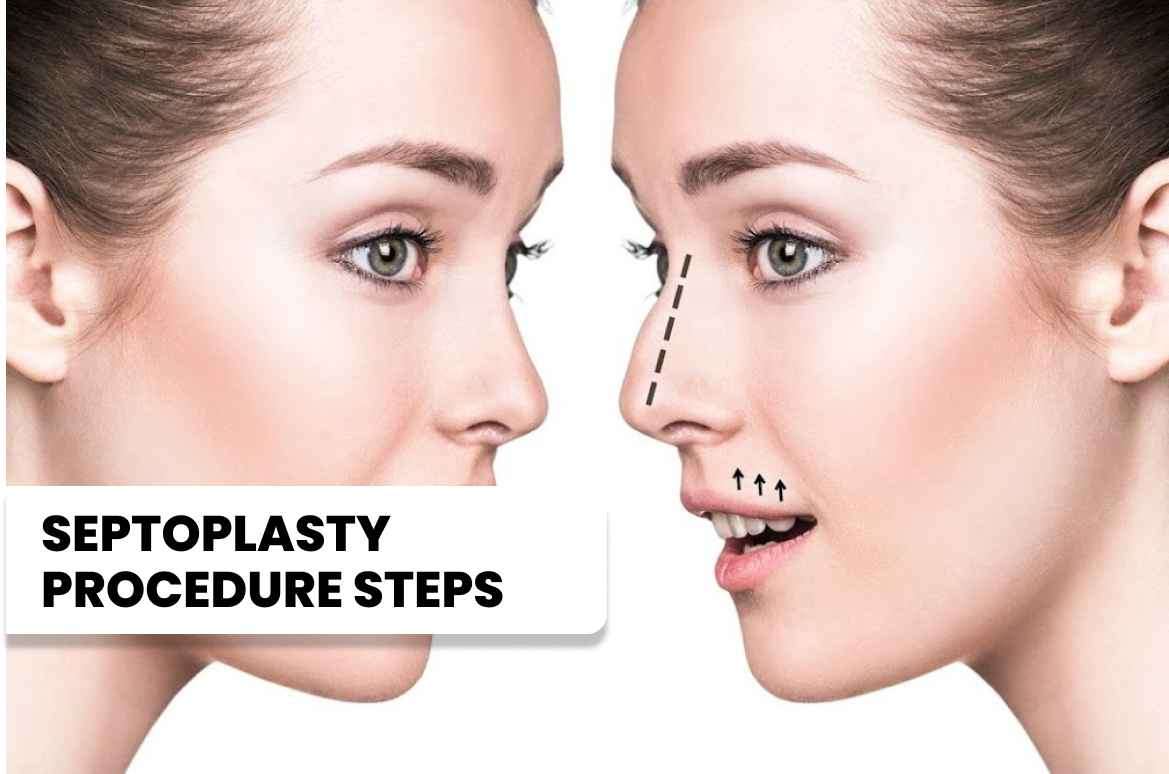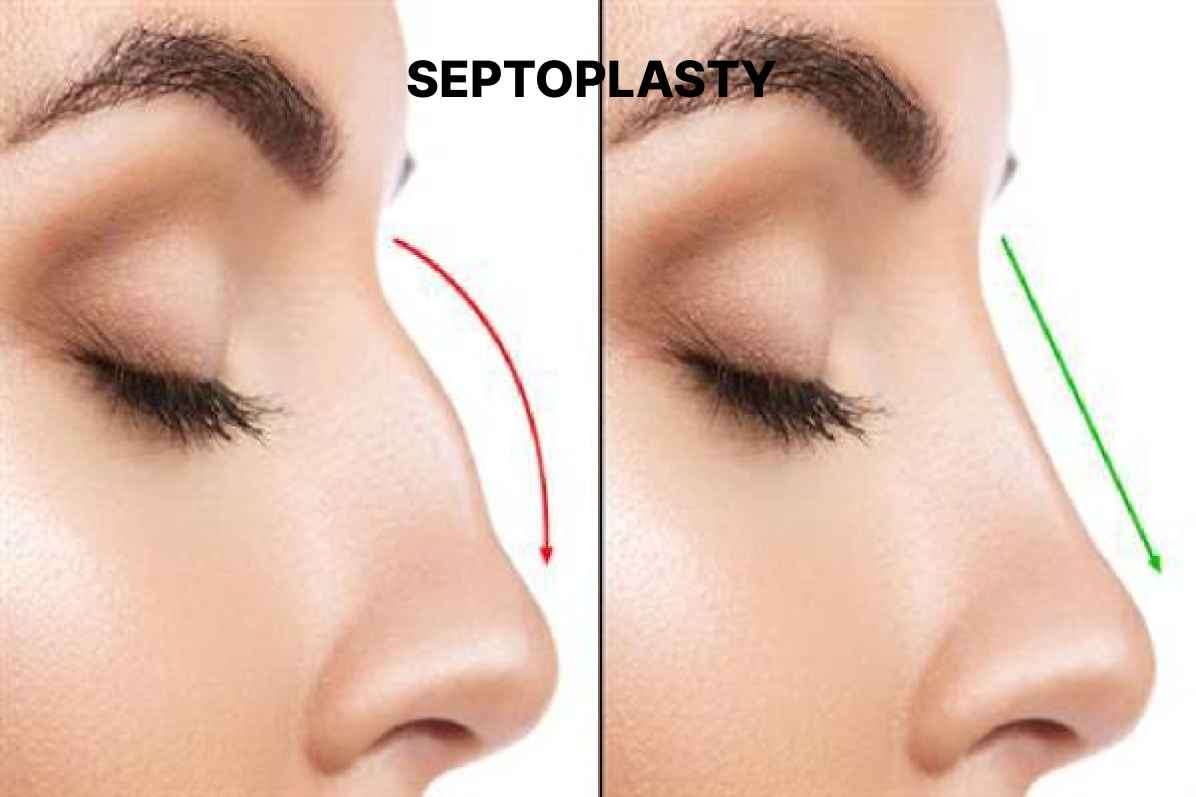Septoplasty is a surgical procedure that is performed to correct a deviated septum. During the procedure, the surgeon will make an incision inside the nose and remove or reposition the cartilage and bone that is causing the deviation. In some cases, the septum may be straightened by trimming or reshaping it, or by inserting splints or grafts to support the newly aligned septum. The procedure typically takes between 30 and 90 minutes, and can be performed under local or general anesthesia.
Why is Septoplasty(DNS surgery) Performed?
DNS Septoplasty is usually performed to correct a deviated septum, which is a condition in which the septum is crooked or misaligned. This can cause breathing difficulties, nasal congestion, and other problems that can affect a person's quality of life. A deviated septum can also cause snoring, sleep apnea, and other sleep-related problems. In some cases, septoplasty may be performed in conjunction with other procedures, such as rhinoplasty or sinus surgery, to address additional issues with the nasal cavity.
What are the Risks and Benefits of Septoplasty?
Septoplasty is generally a safe and effective procedure that can provide significant relief for those who are experiencing breathing difficulties or other issues related to a deviated septum. Some of the benefits of septoplasty include improved nasal function, reduced snoring and sleep apnea, and an overall improvement in quality of life. However, as with any surgical procedure, there are some risks and potential complications to consider. These may include bleeding, infection, scarring, and changes in the shape or size of the nose. In rare cases, septoplasty may also lead to a perforated septum or a loss of sense of smell.
How to Prepare for Septoplasty?
To prepare for septoplasty, it is important to speak with your healthcare provider about any medications or supplements you are taking, as these may need to be adjusted before the procedure. You may also be instructed to stop smoking, as smoking can increase the risk of complications during and after surgery. In some cases, you may be asked to undergo a pre-operative evaluation, which may include blood tests, imaging studies, or other diagnostic tests to assess your overall health and suitability for surgery.
What to Expect During and After Septoplasty?
Septoplasty is typically performed on an outpatient basis, which means that you can usually go home the same day as the procedure. After the surgery, your nose may be packed with gauze or other materials to help control bleeding and support the newly aligned septum. You may also experience some swelling, bruising, and discomfort for the first few days after the procedure, and your doctor may prescribe pain medication or other medications to help manage these symptoms. You may be advised to avoid strenuous activities, heavy lifting, or other activities that could put stress on your nose for several weeks after the procedure. Most people are able to return to work or normal activities within a week or two after septoplasty, although it may take several weeks or months to fully recover.
Septoplasty procedure steps Anesthesia: The patient is given either general anesthesia or local anesthesia with sedation to ensure they are comfortable and pain-free during the surgery. Incision: The surgeon will make an incision inside the nostril on the side of the deviated septum. In some cases, an additional incision may be made on the outside of the nose. Separation: The surgeon will then separate the mucous membrane lining of the septum from the underlying cartilage and bone. Reshaping: The surgeon will carefully reshape the cartilage and bone to straighten the septum, using surgical instruments such as scissors, forceps, and a scalpel. The goal is to create a more open nasal passage and improve airflow. Repositioning: Once the septum has been reshaped, the surgeon will reposition the mucous membrane lining and close the incision with dissolvable stitches. Packing: In some cases, the surgeon may place soft packing material inside the nose to support the septum and help reduce bleeding. Recovery: After the procedure, the patient will be monitored in a recovery room until they are awake and alert. Most patients are able to go home the same day. When should u consider
Septoplasty
Chronic nasal congestion: If you are experiencing persistent nasal congestion that is not improving with over-the-counter medications, or if you are having trouble breathing through your nose, you may have a deviated septum that is obstructing your airway. Recurrent sinus infections: A deviated septum can also contribute to chronic sinus infections by blocking proper drainage of the sinuses. If you are experiencing recurrent sinus infections or sinus pressure and pain, septoplasty may be recommended to improve sinus drainage. Sleep apnea or snoring: A deviated septum can also contribute to sleep apnea or snoring by obstructing the airway during sleep. If you are experiencing these sleep-related issues, septoplasty may be recommended to help improve breathing during sleep.

Septoplasty procedure steps
Anesthesia: The patient is given either general anesthesia or local anesthesia with sedation to ensure they are comfortable and pain-free during the surgery.
Incision: The surgeon will make an incision inside the nostril on the side of the deviated septum. In some cases, an additional incision may be made on the outside of the nose.
Separation: The surgeon will then separate the mucous membrane lining of the septum from the underlying cartilage and bone.
Reshaping: The surgeon will carefully reshape the cartilage and bone to straighten the septum, using surgical instruments such as scissors, forceps, and a scalpel. The goal is to create a more open nasal passage and improve airflow.
Repositioning: Once the septum has been reshaped, the surgeon will reposition the mucous membrane lining and close the incision with dissolvable stitches.
Packing: In some cases, the surgeon may place soft packing material inside the nose to support the septum and help reduce bleeding.
Recovery: After the procedure, the patient will be monitored in a recovery room until they are awake and alert. Most patients are able to go home the same day.
When should u consider Septoplasty
Chronic nasal congestion: If you are experiencing persistent nasal congestion that is not improving with over-the-counter medications, or if you are having trouble breathing through your nose, you may have a deviated septum that is obstructing your airway.
Recurrent sinus infections: A deviated septum can also contribute to chronic sinus infections by blocking proper drainage of the sinuses. If you are experiencing recurrent sinus infections or sinus pressure and pain, septoplasty may be recommended to improve sinus drainage.
Sleep apnea or snoring: A deviated septum can also contribute to sleep apnea or snoring by obstructing the airway during sleep. If you are experiencing these sleep-related issues, septoplasty may be recommended to help improve breathing during sleep.
Septoplasty and turbinoplasty Septoplasty and Turbinoplasty can be performed together(Septoturbinoplasty) or separately, depending on the individual patient's needs. Both procedures are usually performed under general anesthesia and can take around one to two hours to complete. Recovery time varies depending on the extent of the surgery, but most patients can go home the same day and return to work within a week or two. As with any surgery, there are risks associated with both Septoplasty and Turbinoplasty, and patients should discuss these risks with their surgeon before undergoing the procedure. Rhinoplasty and Septoplasty Rhino-septoplasty is a surgical procedure that combines Rhinoplasty (nose reshaping surgery) with Septoplasty (surgery to correct a deviated septum). It's a common procedure that can improve both the form and function of the nose. During rhino-septoplasty, the surgeon will make incisions inside the nostrils to access the septum and the nasal bones and cartilage. They will then reshape and reposition the structures to improve breathing and correct any cosmetic concerns. Some of the benefits of rhino-septoplasty include improved breathing, relief from snoring or sleep apnea, improved facial symmetry and balance, and improved overall facial aesthetics. The procedure can be performed on its own or in conjunction with other facial plastic surgeries, such as chin augmentation or eyelid surgery. SMR (Submucous Resection) and Septoplasty are both surgical procedures used to address breathing problems caused by structural issues in the nose. SMR is a surgical procedure used to remove excess tissue from the nasal turbinates, which are structures inside the nose that help filter and humidify the air we breathe. If the turbinates are enlarged or swollen, they can obstruct airflow and cause breathing problems. During SMR, the surgeon will remove or reduce the size of the turbinate tissue to improve breathing. Septoplasty, on the other hand, is a surgical procedure used to correct a deviated septum, which is the cartilage and bone that separates the nasal passages. When the septum is deviated, it can cause breathing problems, snoring, and other issues. During septoplasty, the surgeon will make incisions inside the nostrils to access the septum and then remove or reshape the affected tissue. Both SMR and septoplasty can be performed together or separately, depending on the individual patient's needs. The procedures are usually performed under general anesthesia and can take around one to two hours to complete. Recovery time varies depending on the extent of the surgery, but most patients can go home the same day and return to work within a week or two.

Septoplasty and turbinoplasty
Septoplasty and Turbinoplasty can be performed together(Septoturbinoplasty) or separately, depending on the individual patient's needs. Both procedures are usually performed under general anesthesia and can take around one to two hours to complete. Recovery time varies depending on the extent of the surgery, but most patients can go home the same day and return to work within a week or two. As with any surgery, there are risks associated with both Septoplasty and Turbinoplasty, and patients should discuss these risks with their surgeon before undergoing the procedure.
Rhinoplasty and Septoplasty Rhino-septoplasty is a surgical procedure that combines Rhinoplasty (nose reshaping surgery) with Septoplasty (surgery to correct a deviated septum). It's a common procedure that can improve both the form and function of the nose. During rhino-septoplasty, the surgeon will make incisions inside the nostrils to access the septum and the nasal bones and cartilage. They will then reshape and reposition the structures to improve breathing and correct any cosmetic concerns. Some of the benefits of rhino-septoplasty include improved breathing, relief from snoring or sleep apnea, improved facial symmetry and balance, and improved overall facial aesthetics. The procedure can be performed on its own or in conjunction with other facial plastic surgeries, such as chin augmentation or eyelid surgery. SMR (Submucous Resection) and Septoplasty are both surgical procedures used to address breathing problems caused by structural issues in the nose. SMR is a surgical procedure used to remove excess tissue from the nasal turbinates, which are structures inside the nose that help filter and humidify the air we breathe. If the turbinates are enlarged or swollen, they can obstruct airflow and cause breathing problems. During SMR, the surgeon will remove or reduce the size of the turbinate tissue to improve breathing. Septoplasty, on the other hand, is a surgical procedure used to correct a deviated septum, which is the cartilage and bone that separates the nasal passages. When the septum is deviated, it can cause breathing problems, snoring, and other issues. During septoplasty, the surgeon will make incisions inside the nostrils to access the septum and then remove or reshape the affected tissue. Both SMR and septoplasty can be performed together or separately, depending on the individual patient's needs. The procedures are usually performed under general anesthesia and can take around one to two hours to complete. Recovery time varies depending on the extent of the surgery, but most patients can go home the same day and return to work within a week or two.
Given below is the cost of surgery in different Indian cities.
Please Wait..